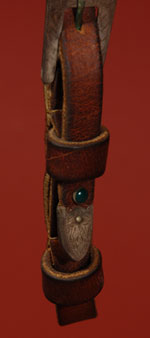Special Value Offer: Diné (Navajo) Silver and Turquoise Headstall & Leather Quirt [SOLD]
+ Add to my watchlist Forward to Friend
- Category: Other Items
- Origin: Diné of the Navajo Nation
- Medium: silver, leather, turquoise, metal
- Size: 23” tall x 10” wide (bridle); 28” tall (quirt)
- Item # C3239 SOLD
Special Value Offer: The consignor of this Headstall and Quirt has authorized us to reduce the price by 30% from the original price of $9500 (the appraised price) to a new price of $6650.

 At the time the Spaniards introduced horses to the Navajo, it gave them mobility to plunder and raid their neighbors. They rapidly became a semi-nomadic people and lavished beautiful blankets and silver on their horses, much like the Plains Indians did with beadwork. Their lifestyle paralleled that of another nomadic peoples who lived in deserts and treasured their horses—the Arabs.
At the time the Spaniards introduced horses to the Navajo, it gave them mobility to plunder and raid their neighbors. They rapidly became a semi-nomadic people and lavished beautiful blankets and silver on their horses, much like the Plains Indians did with beadwork. Their lifestyle paralleled that of another nomadic peoples who lived in deserts and treasured their horses—the Arabs.
This is an early 20th century Navajo headstall with stamped and punched conchas on either side of a beautiful centerpiece with repoussé design and with a silver naja suspended from it. The leather terminal connectors, which join the headstall to the bit, are encased in beautifully-stamped silver designs.
The leather quirt is beautifully woven from leather strips in a fashion not knowingly by Navajo artists. This style work is not known in their culture. It is quite possible that it was a trade item to which the owner added turquoise to match the headstall.
Both the headstall and quirt have been mounted on metal stands for display purposes. The sterling silver items on the headstall have not been polished in the 45 years that the headstall has been owned by the current owner. We have chosen to leave the silver unpolished because it helps illustrate the age of the item and some collectors prefer that all patina remain untouched.
Condition: both headstall and quirt are in excellent condition
Provenance: from a New York City collector
Recommended Reading: Indian Silver Jewelry of the Southwest 1868-1930 by Larry Frank






- Category: Other Items
- Origin: Diné of the Navajo Nation
- Medium: silver, leather, turquoise, metal
- Size: 23” tall x 10” wide (bridle); 28” tall (quirt)
- Item # C3239 SOLD



